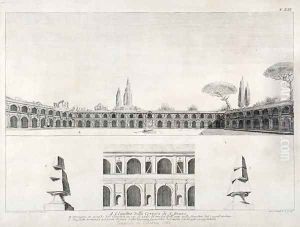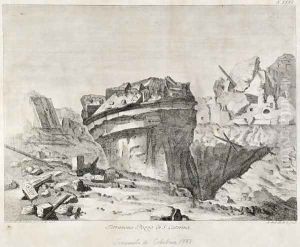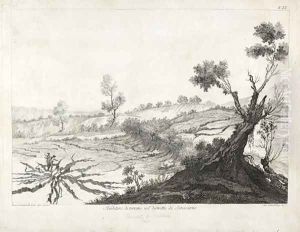Pompeo Schiantarelli Paintings
Pompeo Schiantarelli was an Italian architect and artist, born in 1746 in Osimo, a town in the Marche region of Italy. He emerged as a significant figure during the late 18th and early 19th centuries, a period marked by the transition from Baroque to Neoclassicism in European art and architecture. Schiantarelli's contributions are primarily noted in the realm of architectural design, where he embraced the Neoclassical style, drawing inspiration from the ancient Roman and Greek aesthetics that were being rediscovered and celebrated during his lifetime.
Schiantarelli's education and early career were deeply influenced by the cultural milieu of Italy and the broader European context of the Enlightenment. He studied architecture, possibly in Rome, which was a hub for artists and architects seeking to study ancient ruins directly and apply classical principles to contemporary design. His work reflects a keen interest in the symmetry, proportion, and simplicity that characterized classical architecture, distinguishing him from the more ornate and elaborate Baroque style that preceded his era.
Throughout his career, Pompeo Schiantarelli was involved in various significant projects, particularly in his native Italy, where he contributed to the design and construction of public buildings, churches, and urban planning. His architectural works are noted for their elegance, clarity of form, and the harmonious integration with their surroundings, embodying the ideals of the Neoclassical movement. Schiantarelli's legacy also includes his influence on the next generation of architects and designers, through both his built works and possibly through teaching and mentorship, although specific details of his pedagogical role remain less documented.
Pompeo Schiantarelli passed away in 1820, leaving behind a body of work that continues to be studied by architects and historians for its contribution to the development of Neoclassical architecture in Italy. His life and career exemplify the broader shifts in European art and architecture of his time, from the extravagances of the Baroque to the disciplined elegance of Neoclassicism. Schiantarelli's work remains a testament to the enduring appeal of classical principles in architecture, reflecting a period of significant transition and the search for a universal aesthetic rooted in the past.


